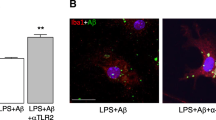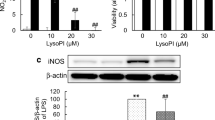Abstract
Recent evidence suggests that metformin shows beneficial effects in experimental models of neuroinflammatory diseases. The aim of the present study was to determine the effect of metformin on phagocytosis and acidification of lysosomal/endosomal compartments in rat primary microglia in the presence of lipopolysaccharide (LPS) and/or beta-peptides (25–35), (1–40), and (1–42). Metformin increased the phagocytosis of fluorescent microspheres in the presence or absence of all the beta-peptides. However, the drug had no effect on the phagocytosis in LPS-stimulated microglia regardless of the presence of all the beta-peptides. Metformin acidified the lysosomal/endosomal compartments in the presence or absence of the beta-peptide 1–40 in both resting and activated microglia. To elucidate the mechanism of metformin action, we used 5-aminoimidazole-4-carboxamide-1-β-d-ribofuranoside as an activator of adenosine monophosphate-activated protein kinase (AMPK) and compound C as a confirmed pharmacological inhibitor of AMPK. We have shown that metformin increased AMPK activity in microglial cells and that all observed effects are AMPK-dependent because the pretreatment of microglia with compound C reversed the effects of the drug. Since degradation of proteins in lysosomal/endosomal compartments depends largely on their phagocytosis and acidification, metformin may be beneficial in proteinopathies affecting the brain.








Similar content being viewed by others
Abbreviations
- AICAR:
-
5-Aminoimidazole-4-carboxamide-1-β-d-ribofuranoside
- AMPK:
-
Adenosine monophosphate-activated protein kinase
- BrdU:
-
5-Bromo-2′-deoxyuridine
- DMEM:
-
Dulbecco's modified Eagle's medium
- FBS:
-
Fetal bovine serum
- GFAP:
-
Glial fibrillary acidic protein
- IOD:
-
Integrated optical density
- LPS:
-
Lipopolysaccharide
- MAP-2:
-
Microtubule associating protein-2
- MTT:
-
3-(4,5-Dimethylthazol-2-yl)-2,5-diphenyltetrazolinum bromide
- RCA-1:
-
Ricinus Communis Agglutinin-1
- RPMI-1640 Medium:
-
Roswell Park Memorial Institute-1640 Medium
- TBST:
-
Tris-buffered saline Tween 20
- SD:
-
Standard deviation
References
Ayasolla KR, Singh AK, Singh I (2005) 5-aminoimidazole-4-carboxamide-1-beta-4-ribofuranoside (AICAR) attenuates the expression of LPS- and Abeta peptide-induced inflammatory mediators in astroglia. J Neuroinflammation 20:2–21
Banati RB, Egensperger R, Maassen A, Hager G, Kreutzberg GW, Graeber MB (2004) Mitochondria in activated microglia in vitro. J Neurocytol 33:535–541
Beckner ME, Gobbel GT, Abounader R, Burovic F, Agostino NR, Laterra J, Pollack IF (2005) Glycolytic glioma cells with active glycogen synthase are sensitive to PTEN and inhibitors of PI3K and gluconeogenesis. Lab Invest 85:1457–1470
Davies SP, Carling DG, Hardie DG (1989) Tissue distribution of the AMP-activated protein kinase and lack of activation by cyclic-AMP-dependent protein kinase studied using a specific and sensitive peptide assay. Eur J Biochem 186:123–128
Dunn KW, Park J, Semrad CE, Gelman DL, Shevell T, McGraw TE (1994) Regulation of endocytic trafficking and acidification are independent of the cystic fibrosis transmembrane regulator. J Biol Chem 269:5336–5345
El-Mir MY, Detaille D, R-Villanueva G, Delgado-Esteban M, Guigas B, Attia S, Fontaine E, Almeida A, Leverve X (2008) Neuroprotective role of antidiabetic drug metformin against apoptotic cell death in primary cortical neurons. J Mo Neurosci 34:77–87
Giri S, Nath N, Smith B, Viollet B, Singh AK, Singh I (2004) 5-Aminoimidazole-4-carboxamide-1-beta-4-ribofuranoside inhibits proinflammatory response in glial cells: a possible role of AMP-activated protein kinase. J Neurosci 24:479–487
Hallows KR, Alzamora R, Li H, Gong F, Smolak C, Neumann D, Pastor-Soler NM (2009) AMP-activated protein kinase inhibits alkaline pH- and PKA-induced apical vacuolar H+-ATPase accumulation in epididymal clear cells. Am J Physiol Cell Physiol 296:672–681
Hanisch UK, Kettenmann H (2007) Microglia active sensor and versatile effectors cells in the normal and pathologic brain. Nat Neurosci 10:1387–1394
Hawley SA, Davison M, Woods A, Davies SP, Beri RK, Carling D, Hardie DG (1996) Characterization of the AMP-activated protein kinase kinase from rat liver and identification of threonine 172 as the major site at which it phosphorylates AMP-activated protein kinase. J Biol Chem 271:27879–27887
Isoda K, Young JL, Zirlik A, MacFarlane LA, Tsuboi N, Gerdes N, Schönbeck U, Libby P (2006) Metformin inhibits proinflammatory responses and nuclear factor-kappaB in human vascular wall cells. Arterioscler Thromb Vasc Biol 26:611–617
Kim J, Yoon MY, Choi SL, Kang I, Kim SS, Kim YS, Choi YK, Ha J (2001) Effects of stimulation of AMP-activated protein kinase on insulin-like growth factor 1- and epidermal growth factor-dependent extracellular signal-regulated kinase pathway. J Biol Chem 276:19102–19110
Koenigsknecht J, Landreth G (2004) Microglial phagocytosis of fibrillar beta-amyloid through a beta1 integrin-dependent mechanism. J Neurosci 3:9838–9846
Kopec KK, Carroll RT (1998) Alzheimer's beta-amyloid peptide 1–42 induces a phagocytic response in murine microglia. J Neurochem 71:2123–2131
Kuo CL, Ho FM, Chang MY, Prakash E, Lin WW (2008) Inhibition of lipopolysaccharide-induced inducible nitric oxide synthase and cyclooxygenase-2 gene expression by 5- aminoimidazole-4-carboxamide riboside is independent of AMP-activated protein kinase. J Cell Biochem 103:931–940
Kurz T, Leake A, von Zglinicki T, Brunk UT (2004) Relocalized redox-active lysosomal iron is an important mediator of oxidative-stress-induced DNA damage. Biochem J 378:1039–1045
Labuzek K, Kowalski J, Gabryel B, Herman ZS (2005) Chlorpromazine and loxapine reduce interleukin-1beta and interleukin-2 release by rat mixed glial and microglial cell cultures. Eur Neuropsychopharmacol 5:23–30
Li L, Mamputu JC, Wiernsperger N, Renier G (2005) Signaling pathways involved in human vascular smooth muscle cell proliferation and matrix metalloproteinase-2 expression induced by leptin: inhibitory effect of metformin. Diabetes 54:2227–2234
Lorenzo A, Yankner BA (1994) Beta-amyloid neurotoxicity requires fibril formation and is inhibited by congo red. Proc Natl Acad Sci U S A 91:12243–12247
Ma TC, Buescher JL, Oatis B, Funk JA, Nash AJ, Carrier RL, Hoyt KR (2007) Metformin therapy in a transgenic mouse model of Huntington's disease. Neurosci Lett 411:98–103
Majumdar A, Cruz D, Asamoah N, Buxbaum A, Sohar I, Lobel P, Maxfield FR (2007) Activation of microglia acidifies lysosomes and leads to degradation of Alzheimer amyloid fibrils. Mol Biol Cell 18:1490–1496
Mamputu JC, Wiernsperger NF, Renier G (2003) Antiatherogenic properties of metformin: the experimental evidence. Diabetes Metab 29:6S71–6S76
Medeiros R, Prediger RD, Passos GF, Pandolfo P, Duarte FS, Franco JL, Dafre AL, Di Giunta G, Figueiredo CP, Takahashi RN, Campos MM, Calixto JB (2007) Connecting TNF alpha signaling pathways to iNOS expression in a mouse model of Alzheimer's disease: relevance for the behavioral and synaptic deficits induced by amyloid beta protein. J Neurosci 27:5394–5404
Mosmann T (1983) Rapid colorimetric assay for cellular growth and survival: application to proliferation and cytotoxicity assays. J Immunol Method 65:55–63
Nath N, Khan M, Paintlia MK, Hoda MN, Giri S (2009) Metformin attenuated the autoimmune disease of the central nervous system in animal models of multiple sclerosis. J Immunol 182:8005–8014
Ropelle ER, Pauli JR, Zecchin KG, Ueno M, de Souza CT, Morari J, Faria MC, Velloso LA, Saad MJ, Carvalheira JB (2007) A central role for neuronal adenosine 5′-monophosphate-activated protein kinase in cancer-induced anorexia. Endocrinology 148:5220–5229
Saeedi R, Parsons HL, Wambolt RB, Paulson K, Sharma V, Dyck JR, Brownsey RW, Allard MF (2008) Metabolic actions of metformin in the heart can occur by AMPK- independent mechanisms. Am J Physiol Heart Circ Physiol 294:2497–2506
Sanders MJ, Grondin PO, Hegarty BD, Snowden MA, Carling D (2007) Investigating the mechanism for AMP activation of the AMP-activated protein kinase cascade. Biochem J 403:139–148
Satoh J, Kim SU (1995) Ganglioside markers GD3, GD2, and A2B5 in fetal human neurons and glial cells in culture. Dev Neurosci 17:137–148
Stott DI (1989) Immunoblotting and dot blotting. J Immunol Methods 119:153–187
Sun W, Lee TS, Zhu M, Gu C, Wang Y, Zhu Y, Shyy JY (2006) Statins activate AMP-activated protein kinase in vitro and in vivo. Circulation 114:2655–2662
Tamás P, Hawley SA, Clarke RG, Mustard KJ, Green K, Hardie DG, Cantrell DA (2006) Regulation of the energy sensor AMP-activated protein kinase by antigen receptor and Ca2+ in T lymphocytes. J Exp Med 203:1665–1670
Towbin H, Staehelin T, Gordon J (1979) Electrophoretic transfer of proteins from polyacrylamide gels to nitrocellulose sheets: procedure and some applications. Proc Natl Acad Sci U S A 76:4350–4354
Towler MC, Hardie DG (2007) AMP-activated protein kinase in metabolic control and insulin signaling. Circ Res 100:328–341
Vazquez-Martin A, Oliveras-Ferraros C, Menendez JA (2009) The antidiabetic drug metformin suppresses HER2 (erbB-2) oncoprotein overexpression via inhibition of the mTOR effector p70S6K1 in human breast carcinoma cells. Cell Cycle 8:88–96
Wilcock C, Bailey CJ (1994) Accumulation of metformin by tissues of the normal and diabetic mouse. Xenobiotica 24:49–57
Wilcock C, Wyre ND, Bailey CJ (1991) Subcellular distribution of metformin in rat liver. J Pharm Pharmacol 43:442–444
Zen K, Biwersi J, Periasamy N, Verkman AS (1992) Second messengers regulate endosomal acidification in Swiss 3 T3 fibroblasts. J Cell Biol 119:99–110
Zhou G, Myers R, Li Y, Chen Y, Shen X, Fenyk-Melody J, Wu M, Ventre J, Doebber T, Fujii N, Musi N, Hirshman MF, Goodyear LJ, Moller DE (2001) Role of AMP-activated protein kinase in mechanism of metformin action. J Clin Invest 108:1167–1174
Zou MH, Kirkpatrick SS, Davis BJ, Nelson JS, Wiles WG 4th, Schlattner U, Neumann D, Brownlee M, Freeman MB, Goldman MH (2004) Activation of the AMP-activated protein kinase by the anti-diabetic drug metformin in vivo. Role of mitochondrial reactive nitrogen species. J Biol Chem 279:43940–43951
Acknowledgements
The authors are thankful to Mrs. Jaroslawa Sprada, Mrs. Halina Klimas, and Mrs. Anna Bielecka for their excellent technical support. This work was supported by a research grant KNW-2-092/09 from Medical University of Silesia, Katowice, Poland. None of the authors has any conflict of interest. The study was approved by the Ethical Committee of the Medical University of Silesia. The experiments comply with the current law of Poland.
Author information
Authors and Affiliations
Corresponding author
Additional information
An erratum to this article is available at http://dx.doi.org/10.1007/s00210-017-1350-y.
Electronic supplementary materials
Below is the link to the electronic supplementary material.
Supplement 1
PDF 1.44 MB
Rights and permissions
About this article
Cite this article
Łabuzek, K., Liber, S., Gabryel, B. et al. Metformin increases phagocytosis and acidifies lysosomal/endosomal compartments in AMPK-dependent manner in rat primary microglia. Naunyn-Schmied Arch Pharmacol 381, 171–186 (2010). https://doi.org/10.1007/s00210-009-0477-x
Received:
Accepted:
Published:
Issue Date:
DOI: https://doi.org/10.1007/s00210-009-0477-x




